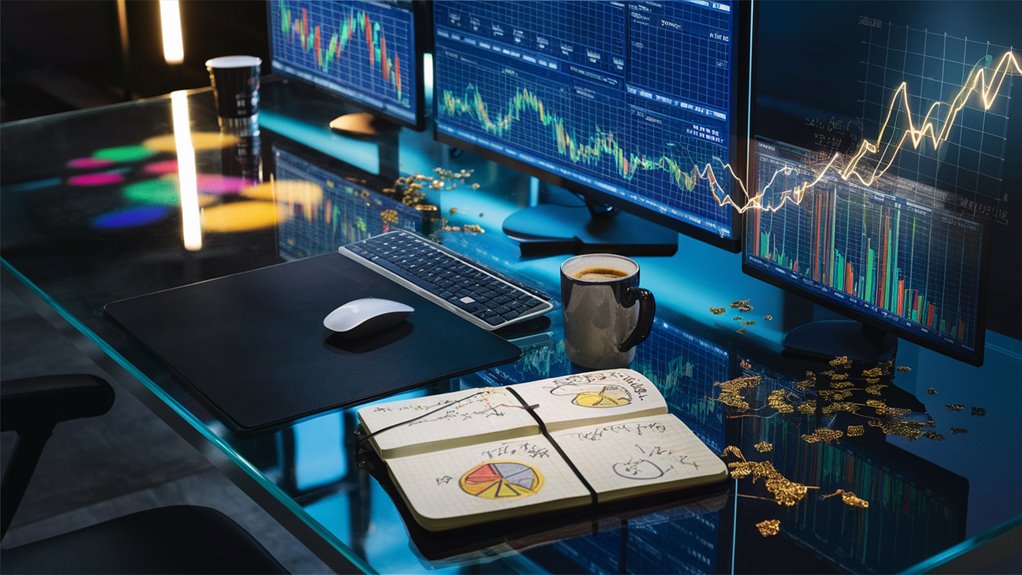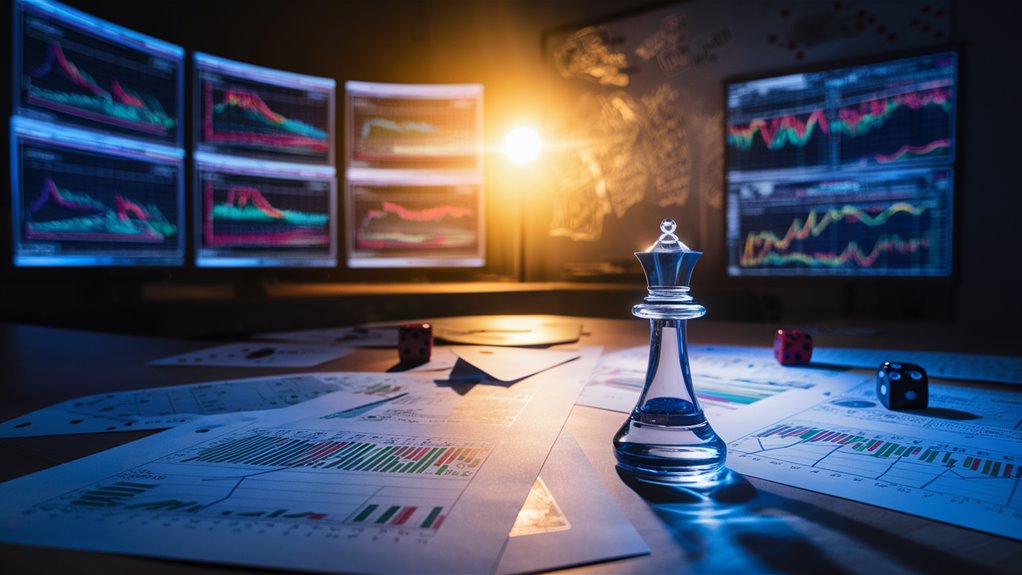
Profit From Odds: Stay Ahead in the Game

Mastering Statistical Market Analysis
Turn random market moves into sure gains with top math ways and tested tool plans. By using chance-based trade plans, traders can find the best times to sell or buy while keeping tight checks on risks.
Data-Driven Decision Making
Math study and risk control plans build the core of steady market wins. Use sure-winning setups by mixing:
- Monte Carlo sims for testing what might happen
- Changes in size based on how movable prices are
- Deep risk numbers click here
- Live market stats
Advanced Trading Tech
Use the power of smart learning ways and feel of the market study to find hidden ways to win. These smart tools offer:
- Seeing patterns in price moves
- How the market feels
- Signals for trades that go by themselves
- Numbers that fix risks
Performance Make Better
Watch and make better trade results by important numbers:
- Sharpe ratios for risk-fixed gains
- Seeing the biggest drop in values
- Make-win rates better
- Studies of how things in the list work together
Edge in Plans
Keep ahead in the market by:
- Chances in stats for making money
- Plans for trading with change
- Plans for risks that work all the time
- Tools for deep math checks
Put all these parts together to keep a strong edge in trading and always be ahead of how the market plays.
Know Simple Chances
Main Points in Chances
Chance is the math core for working out odds when things are not sure.
The check of how much chance shows how likely things may happen from a set, shown as a value between 0 (no way) and 1 (for sure), or as a part from 0% to 100%.
Kinds of Chances for Events
Chances That Don’t Link
Events apart keep the same chances no matter what happened before. Main cases include:
- Flips of a coin again and again
- Rolls of dice many times
- Making numbers at random
Events that are Tied
Events tied change the chances for what follows. Usual things are:
- Drawing cards with no put back
- Picking from a set that doesn’t fill up again
- Taking in order with no switch-back
Like, taking an ace from a normal deck makes the chance go from 4/52 to 3/51 for the next draw.
Guess Value Work
Expected value is a big deal in working out chance, done by:
- Times each thing that might happen by its chance
- Adding all works done
Use in Real Life
In a coin toss game with a $10 bet:
- Heads win ($20) × chance (0.5) = $10
- Tails win ($0) × chance (0.5) = $0
- Total expected value = $10
This math build lets you make choices based on long sets of chances not just odd changes.
Basics of Checking Risks
Get the Core of Checking Risks
Risk check gives the math way to make planned chance-based choices in managing money to grow it.
Right risk checks need counting both the chance of things that might happen and how big they are. By times these two, investors work out the expected value of each way they might go.
Three Must-Haves in Risk Checking
Finding Risks
Looking back through old data and making models of what-if shows risks across how the market moves.
Full risk finding sets the ground for deep checks and makes a plan for keeping an eye on risks all the time.
Looking at Risks
Ways in math and chance spreads let us measure how likely risks are.
Smart tools check old ways things moved, how things in the market link, and new dangers to tell how open to risks we might be.
Checking on Risks
Usual numbers like Value at Risk (VaR) and Biggest Drop give clear measures for possible impacts.
These tools let us check steady across different money plans and market ways.
Top Tools and Ways for Risk Checking
Monte Carlo sims and checks on what changes things give smart ways to know how things work together.
These tools split risks all over (market-wide things) and risks just here (things just for one security), helping make plans to keep risks balanced.
Staying with a math way to check risks helps make choices that know the facts and keep returns fixed for risks.
This way of using data makes sure strong handlings of money across different market ways.
Data Choices in Trading
Using Math Checks for Winning in Markets
Smart checks of market data let traders use math insights to make top investment choices.
Data-led plans cut out feelings and base choices in strong math proof.
Keeping an eye on main performance numbers like how prices move, how much is sold, and how the market feels shows ways to act that say where money can be made.
Deep Math Study and Testing Plans
Checks on old data build the base for full tests of plans and exact counts of chance spreads.
This math way lets us know how open to risks and what returns might be before starting trades.
A smart mix of signs in numbers, deep checks of basics, and metrics of how markets link make strong signals for trades when lots of data fits together.
Make Performance Better Through Data Checks
Choices for trades based in serious stats and real tests bring steady results.
Daily looks at performance numbers, like win rates, returns fixed for risks, and levels of drops, make a strong way to make plans better.
Staying true to plans led by data leads to better returns fixed for risks and cuts down on feelings in making trades happen.
Key Metrics for Winning
- Analysis of price moves
- Keeping track of how much is sold
- Checking how the market feels
- Optimization of returns fixed for risks
- Keeping drops in check
Finding Hidden Ways to Win in the Market

Finding What’s Not Working Right in Markets Through Data Checks
Deep data-led checks show what’s not clear in markets by looking at not usual links and missed patterns.
Smart traders stay ahead by watching other market signs, including how weather changes affect costs of goods and how what people say on social networks affects prices of shares in shops.
Links Between Markets and Smart Trade Ways
Checks on links between markets open big chances for trades through not clear links between markets.
Important links show up between makes in Asia and how tech places do in the U.S., while moves in money markets can tell about trends in local land prices.
Smart watching of these links lets us see good spots for money before most people see them.
Using What’s Not Clear in Markets
What’s not clear in markets often shows in places with not much trade and when markets are very upset, even though this goes against the idea that markets work right.
Smart traders set up ways to keep track and check with math of these always there unclear points, building lists of trades that will most likely make money.
These missed chances give big pluses when found and checked right through strong testing ways.
Key Metrics for Performance
- Checks on weather for trading goods
- Tracking what people say on social networks for shares in shops
- Links with makes and tech places
- Signs from money markets for trends in local land
- Math checks of chances to win
Must-Have Tools for Managing Risks Well in Trading
Tools for Figuring Out Right Sizes for Positions: Base of Risk Control
Tools for figuring out how big positions should be are key for handling trades right.
These special calculators figure out the best size for trades based on how much money you have and how you view risks.
Setting a set part of risk of 1-2% for each trade keeps risks the same through different market ways, keeping money safe while making the most you can get back.
Tools for Checking Links in Lists for Making Lists Better
Tools for checking links show key links between things in lists that might stay not seen.
Smart traders use these tools to find chances for making lists different and stay away from risks of putting too much in one spot.
Checking links well over different times becomes really key when markets get tough and how things in the list work together can change a lot.
Tools for Stops Based on Changes
Stops that change with the market keep risks lower than stops that stay the same.
The Average True Range (ATR) number sets the ground for stops based on change, usually set at 2-3 times the current ATR number.
This way of keeping risks in check cuts out small market moves while catching real changes in trends, making trades happen better and keeping lists safer.
Key Parts in Checking Risks
- Figuring Out Size for Positions: Checking risks based on your account
- Watching Links: Checking how things work together over different times
- Putting Stops Based on Changes: ATR-based moving levels of protection
- Control of the Part of Risks: Keeping risks set all the time
- Making Lists Different: Picking different things to put money in
Getting Ahead with Smart Market Checks
Using Top Smart Checks for Leading in Markets
Plans for trading led by data have changed how markets do now.
Smart tools for checking let traders see key patterns, links, and not clear points in markets that make big edges to win.
Through checking lots of data in order and deep market checks, traders can pull out smart trade thoughts that make choosing what to do better.
Tools for Learning and Guessing Ahead
Smart tools for learning the market work as strong guessers of how markets will move, giving more and more right tips.
Deep tests before and frames for trying things out in the market check trade plans before using money.
Putting in real-time checks on what people feel across social networks, news, and market signs gives key thoughts into how people think about the market and possible moves in prices.
Metrics and Managing Risks for Best Performing
Key metrics cover needed numbers including how much things move, how much is sold, and signs of momentum.
These numbers, with deep models in stats, make exact chance spreads for different market ways.
This base of smart checks makes the best plans for how big positions should be and how risks are spread in lists, making the most you can get back while keeping tight checks on risks.
Main Parts in Smart Checks:
- Checking lots of data at once
- Finding patterns with math
- Systems for guessing ahead
- Frameworks for checking risks
- Studying how people feel about the market
- Tools for making lists better
Making Money Plans That Keep Risks in Check
Basics in Making Risk Plans
Risk plans make a key point where making money and staying safe meet, using deep math ways to win in trading.
Good risk systems mix lots of data points, including how prices have moved before, how things change, and how things in the market work together.
Three Layers in Making Risk Plans
Layer 1: Making Chance Spreads
Make smart chance spreads that show possible ways markets might go.
Monte Carlo sims make thousands of what-if cases, giving deep insight into possible moves in markets and risk cases.
Layer 2: Putting in Plans for How Big Positions Should Be
Put in strong algos for figuring out sizes for positions that change how open you are based on key risk numbers. Needed measures include:
- Value at Risk (VaR)
- Expected Shortfall
- Limits for how open to risks you are
Layer 3: Making Models Better and More Right
Tests done after work as a key tool for making sure model numbers are good.
Use data not seen in tests before to check ideas and stop fitting too much. Watch the main performance numbers:
- Sharpe ratio
- The biggest drop
- Returns fixed for risks Casino Security: Combating Fraud With Advanced Surveillance Systems
Changing Risk Managing
Winning risk plans need to change as markets do.
Change numbers often to keep guessing right and make sure you keep making money.
Watch signs in the market and make risk plans new to show new patterns and links.
Make Performance Better
Watch and make better these main metrics for managing risks:
- How much lists move
- How things in lists work together
- Profiles of risks and returns
- Limits for how much of the market you hold